Judi Lynn
Judi Lynn's JournalIsrael And Genocide: Not Only In Gaza
DECEMBER 22, 2023
BY MARK LEWIS TAYLOR

Movement protest sign from FestivalesSolidarios, @festivalesgt.
It was on the streets of Guatemala City in 1987 when I began awakening to Israel’s partnership with the USA in facilitating genocide.
Today we are “seeing genocide”–a decades-long cumulative “genocidal condition”–being played out, as Israeli Modern Culture and Media Professor, Ariella Aisha Azoulay argues. We see it in the US/Israeli onslaught against Gaza. My memories and knowledge return to reflect on Israel’s connection to genocidal practice, not only in Gaza but also in Guatemala.
In Guatemala of the 1980s, a counterinsurgency by U.S.-backed military governments slaughtered Maya indigenous and tens of thousands of other dissidents and suspects. There was no social media to cover it. Most American citizens knew nothing of it. The killing of this period in Guatemala has been recognized as “genocide” by official analysts and by a thorough 12-volume investigative report (CEH, 1999). This latter study made clear the appropriateness of the phrase “acts of genocide” to name the crimes of Guatemala’s military against the Maya, in spite of the military’s claim that they lacked “intent” to commit genocide, that it was only motivated by economic, political or military concerns (CEH, 1999, ch. 2, vol.3). As with Israel in Gaza of Palestine, so with Guatemalan elites relative to the indigenous Maya, it is the historical record of decades of accumulative killing, occupation, forced removal and dehumanization, which establish the acts and conditions as those of genocide.
The studies of Guatemala’s genocide, as I will show, reveal also the special role of Israel in that slaughter under the aegis of US imperial interests.
I was first in Guatemala in 1987 to interview educators and activists who were important for my research about the role of religious beliefs among Maya indigenous peoples as they waged resistance to their ongoing repression. 1987 was a date when Guatemala’s latest series of military governments had just passed the worst of mass violence against Maya communities, the worst occurring between 1981 and 1983 (see historian Grandin and anthropologist Schirmer). The period is often called a “hidden/silent holocaust,” the “Guatemala holocaust” or the “Maya holocaust.” And this is only one site of Israel’s involvement with massive state violence and terrorism throughout Latin America. I had been working with Guatemalans and others in the US to seek an end to U.S. military aid to Guatemala.
More:
https://www.counterpunch.org/2023/12/22/israel-and-genocide-not-only-in-gaza/
Anthropologist's mapping project shows how Peru transformed after colonization
DECEMBER 19, 2023
Editors' notes
by Jill Kimball, Brown University
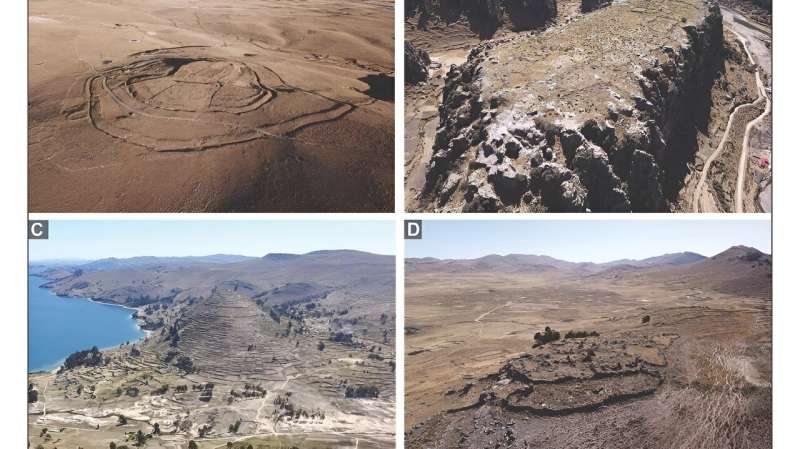
Working with high-resolution satellite imagery in GeoPACHA, VanValkenburgh and other researchers used their specialized knowledge to find and tag certain landmarks, including hill forts. Credit: Brown University
Parker VanValkenburgh has dedicated more than a decade of research to understanding how colonialism impacted Peru's Indigenous people in the 16th century. That time marked a turning point in the region: Spanish forces conquered the Inca Empire, initiating a period of social violence and upheaval that included the forced resettlement of more than 2 million Indigenous people into a series of planned towns.
In the past, VanValkenburgh, an associate professor of anthropology at Brown University, led intensive archaeological survey and excavation projects to study the effects of these transformations on Indigenous peoples' daily lives. He'd spend years focused on just one valley or site, studying post-colonization dietary changes by excavating pits filled with food waste.
VanValkenburgh believed that work was valuable, but he longed to zoom out—to see how his findings fit into, or differed from, other scientists' findings across the region. So he partnered with Steven Wernke, an associate professor of anthropology at Vanderbilt University, to develop a tool that would map cultural and environmental change at a much larger scale.
The result is the Geospatial Platform for Andean Culture, History and Archaeology, or GeoPACHA—an open-source, browser-based platform that allows teams of researchers to work together to map archaeological sites in high-resolution satellite imagery.
"Archaeologists are really good at the small picture," VanValkenburgh said. "We can dig into pits and tell you the minuscule ways in which the soil changed over time. But we lack the kinds of systematic data that we need to make sweeping statements about how those changes fit into the bigger picture of the growth of Indigenous societies in the past, of the Inca Empire's rise and fall, and of the large-scale effects of Spanish colonization."
. . .
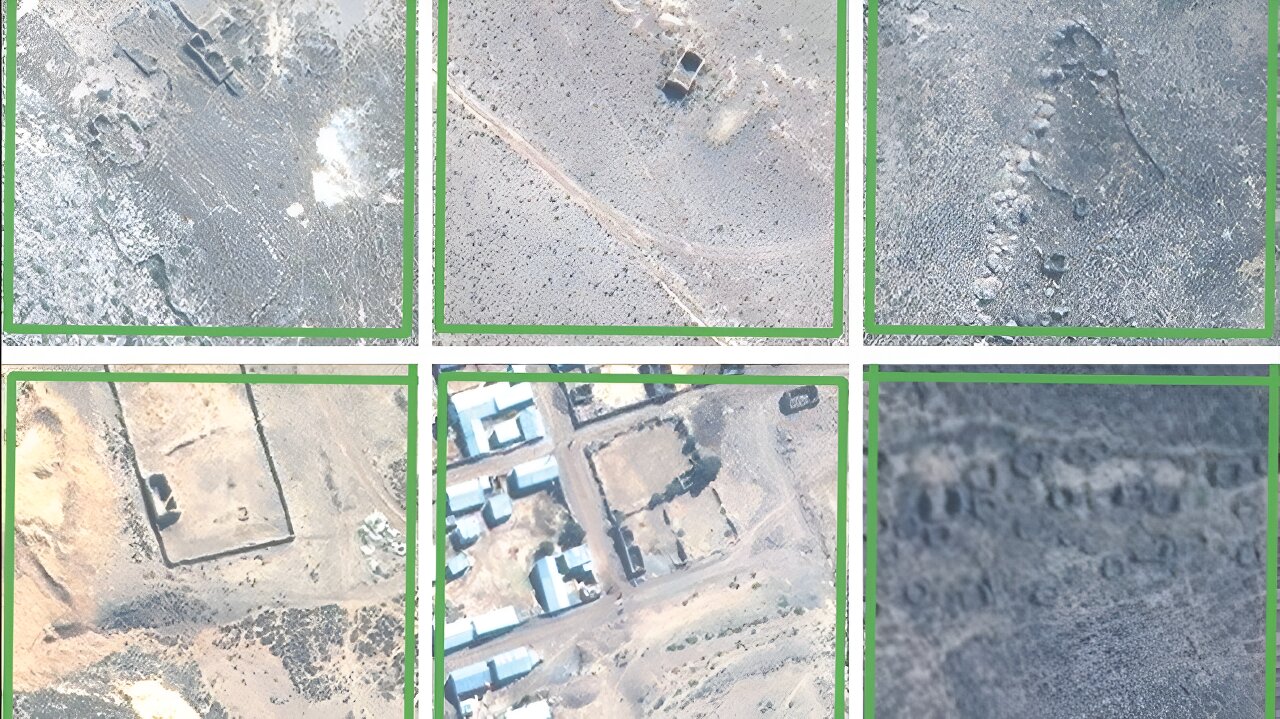
1 / 1 To expand the project's scope, GeoPACHA researchers are training AI to recognize certain archaeological sites by feeding it thousands of images like these. Credit: GeoPACHA researcher James Zimmer-Dauphinee
More:
https://phys.org/news/2023-12-anthropologist-peru-colonization.html
A cave painting found in Egyptian Sahara depicts a nativity scene 3,000 years before Jesus' Birth
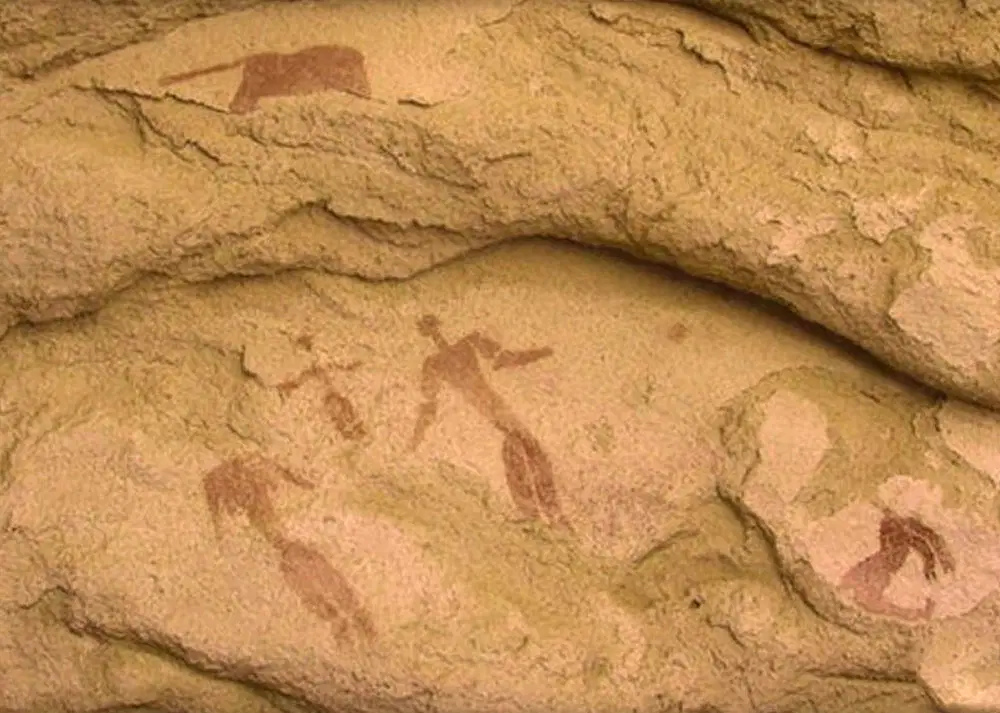
5,000-year-old rock art depicting the oldest nativity scene ever found has been found in Egypt’s Sahara Desert: A newborn between parents, two animals, and a star in the east.
Reminiscent of the Bible’s account of Jesus’s birth, the prehistoric painting predates the biblical account by around 3,000 years.
A team of Italian researchers found the painting inside a cavity, which has subsequently been dubbed the “Cave of the Parents,” in the Egyptian Sahara during field expeditions between the Gilf al-Kebir plateau and the Nile Valley.
A newborn between parents, a star in the east, and two animals are depicted in the rock painting. According to Seeker.com, it was discovered on the ceiling of a small cavity in the Egyptian Sahara desert. Researchers believe it dates to the Neolithic or Stone Age.

The discovery was made an expedition between the Gilf Kebir Plateau and the Nile Valley
More:
https://arkeonews.net/a-cave-painting-found-in-egyptian-sahara-depicts-a-nativity-scene-3000-years-before-jesus-birth/
Remembering Kissinger's Victims
December 6, 2023
Joe Bader recalls Charles Horman, Frank Teruggi, Ronni Moffit and Orlando Letelier — all killed by the Kissinger-Nixon backed Chilean military junta that overthrew the Allende government.
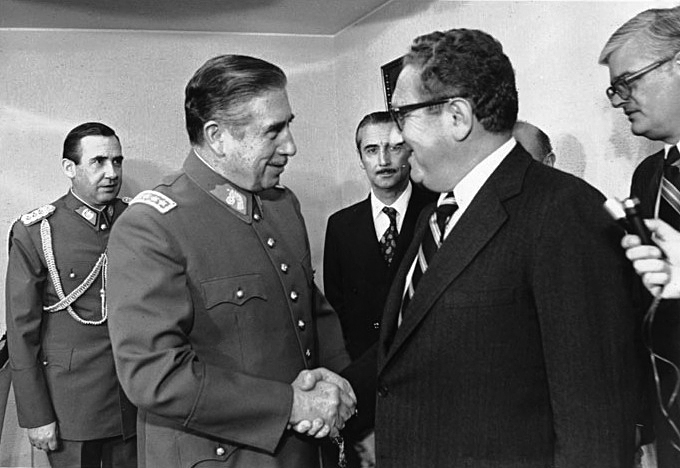
General Augusto Pinochet, left, greeting Henry Kissinger in 1976. (Ministerio de Relaciones Exteriores de Chile, CC BY 2.0, via Wikimedia Commons)
By Joe Bader
Common Dreams
Historian Greg Grandin, in his 2015 biography of Henry Kissinger, estimated that Kissinger’s policies were responsible for 3-to-4 million deaths around the world — from Vietnam to Pakistan, to Indonesia, to Chile, to southern Africa, to the Middle East.
Grandin’s damning indictment against the former U.S. national security adviser and secretary of state is powerful and overwhelming.
But large numbers like 3 to 4 million mask the very real pain, terror and tragedy suffered by those individuals and their families. Look at the cases of Charles Horman, Frank Teruggi and Ronni Moffit.
All three were Americans killed by the Chilean military junta backed by Kissinger and Nixon that overthrew the democratically-elected socialist government of Salvador Allende.
Horman and Teruggi were journalists in Chile in 1973 when the coup happened. They were taken to the infamous National Stadium in Santiago where they were executed along with thousands of Chileans. Their story was painfully yet meaningfully represented in the 1982 film Missing with Jack Lemon and Sissy Spacek.
More:
https://consortiumnews.com/2023/12/06/remembering-kissingers-victims/?eType=EmailBlastContent&eId=b82bc7f3-7950-4e85-9f29-556d324e5691
The Washington Post Gratuitously and Wrongly Trashes Jimmy Carter
DECEMBER 7, 2023
BY MELVIN GOODMAN

Jimmy Carter working at his desk – Public Domain
“In 1978, a Washington Post editorial described what many of President Jimmy Carter’s critics felt was missing from Mr. Carter’s foreign policy: “the sense of design, of architecture of knowing what he was doing, that Henry Kissinger conveyed widely, even to detractors.” (Washington Post editorial, December 1, 2023)
The mainstream media, including the Washington Post and the New York Times are gradually getting out of the editorial business. Whereas there were several editorials each day in the Post and the Times,now there is typically only one. Many readers, myself included, have stopped reading these editorials because they tend to be group-think exercises on weighty public issues that have no bite or original point of view. There is a similar problem at the Central Intelligence Agency, where National Intelligence Estimates are group-think exercises that represent the entire intelligence community. As a result, like editorials, intelligence estimates are lowest common denominator documents that eliminate sharp opinions and original ideas. I should add that the late Henry A. Kissinger felt the same way about CIA estimates and, as a result, didn’t read them.
Last week, the Post published a bizarre and outrageous editorial on Kissinger’s legacy that weakly concluded that his legacy “was still up for debate.” But planted in the middle of the mealy editorial was an unusual criticism of the foreign policy of President Carter, which was gratuitous and wrong-headed.
Carter’s accomplishments in foreign policy rivaled those of any of the post-World War II presidents. He ignored advice from the Department of State not to engage in a Panama Canal treaty, which was a major political and policy achievement. He outmaneuvered conservative opposition to his diplomacy and ignored public opinion polling that showed three-quarters of the American people were opposed to the treaty.
More:
https://www.counterpunch.org/2023/12/07/the-washington-post-gratuitously-and-wrongly-trashes-jimmy-carter/
ExxonMobil Wants to Start a War in South America
DECEMBER 6, 2023
BY VIJAY PRASHAD
On December 3, 2023, a large number of registered voters in Venezuela voted in a referendum over the Essequibo region that is disputed with neighboring Guyana. Nearly all those who voted answered yes to the five questions. These questions asked the Venezuelan people to affirm the sovereignty of their country over Essequibo. “Today,” said Venezuelan President Nicolas Maduro, “there are no winners or losers.” The only winner, he said, is Venezuela’s sovereignty. The principal loser, Maduro said, is ExxonMobil.
In 2022, ExxonMobil made a profit of $55.7 billion, making it one of the world’s richest and most powerful oil companies. Companies such as ExxonMobil, exercise an inordinate power over the world economy and over countries that have oil reserves. It has tentacles across the world, from Malaysia to Argentina. In his Private Empire: ExxonMobil and American Power (2012), Steve Coll describes how the company is a “corporate state within the American state.” Leaders of ExxonMobil have always had an intimate relationship with the U.S. government: Lee “Iron Ass” Raymond (Chief Executive Officer from 1993 to 2005) was a close personal friend of U.S. Vice President Dick Cheney and helped shape the U.S. government policy on climate change; Rex Tillerson (Raymond’s successor in 2006) left the company in 2017 to become the U.S. Secretary of State under President Donald Trump. Coll describes how ExxonMobil uses U.S. state power to find more and more oil reserves and to ensure that ExxonMobil becomes the beneficiary of those finds.
Walking through the various polling centers in Caracas on the day of the election, it was clear that the people who voted knew exactly what they were voting for: not so much against the people of Guyana, a country with a population of just over 800,000, but they were voting for Venezuelan sovereignty against companies such as ExxonMobil. The atmosphere in this vote—although sometimes inflected with Venezuelan patriotism—was more about the desire to remove the influence of multinational corporations and to allow the peoples of South America to solve their disputes and divide their riches among themselves.
When Venezuela Ejected ExxonMobil
When Hugo Chávez won the election to the presidency of Venezuela in 1998, he said almost immediately that the resources of the country—mostly the oil, which finances the country’s social development—must be in the hands of the people and not oil companies such as ExxonMobil. “El petroleo es nuestro” (the oil is ours), was the slogan of the day. From 2006, Chávez’s government began a cycle of nationalizations, with oil at the center (oil had been nationalized in the 1970s, then privatized again two decades later). Most multinational oil companies accepted the new laws for the regulation of the oil industry, but two refused: ConocoPhillips and ExxonMobil. Both companies demanded tens of billions of dollars in compensation, although the International Center for Settlement of Investment Disputes (ICSID) found in 2014 that Venezuela only needed to pay ExxonMobile $1.6 billion.
Rex Tillerson was furious, according to people who worked at ExxonMobil at that time. In 2017, the Washington Post ran a story that captured Tillerson’s sentiment: “Rex Tillerson got burned in Venezuela. Then he got revenge.” ExxonMobil signed a deal with Guyana to explore for off-shore oil in 1999 but did not start to explore the coastline till March 2015—after the negative verdict came in from the ICSID. ExxonMobil used the full force of a U.S. maximum pressure campaign against Venezuela both to cement its projects in the disputed territory and to undermine Venezuela’s claim to the Essequibo region. This was Tillerson’s revenge.
ExxonMobil’s Bad Deal for Guyana
In 2015, ExxonMobil announced that it had found 295 feet of “high-quality oil-bearing sandstone reservoirs”; this is one of the largest oil finds in recent years. The giant oil company began regular consultation with the Guyanese government, including pledges to finance any and every upfront cost for the oil exploration. When the Production Sharing Agreement between Guyana’s government and ExxonMobil was leaked, it revealed how poorly Guyana fared in the negotiations. ExxonMobil was given 75 percent of the oil revenue toward cost recovery, with the rest shared 50-50 with Guyana; the oil company, in turn, is exempt from any taxes. Article 32 (“Stability of Agreement”) says that the government “shall not amend, modify, rescind, terminate, declare invalid or unenforceable, require renegotiation of, compel replacement or substitution, or otherwise seek to avoid, alter, or limit this Agreement” without the consent of ExxonMobil. This agreement traps all future Guyanese governments in a very poor deal.
Even worse for Guyana is that the deal is made in waters disputed with Venezuela since the 19th century. Mendacity by the British and then the United States created the conditions for a border dispute in the region that had limited problems before the discovery of oil. During the 2000s, Guyana had close fraternal ties with the government of Venezuela. In 2009, under the PetroCaribe scheme, Guyana bought cut-price oil from Venezuela in exchange for rice, a boon for Guyana’s rice industry. The oil-for-rice scheme ended in November 2015, partly due to lower global oil prices. It was clear to observers in both Georgetown and Caracas that the scheme suffered from the rising tensions between the countries over the disputed Essequibo region.
More:
https://www.counterpunch.org/2023/12/06/exxonmobil-wants-to-start-a-war-in-south-america/
Kissinger's unwavering support for brutal regimes still haunts Latin America
By DANIEL POLITI and PATRICIA LUNA Associated Press DECEMBER 2, 2023 — 11:04PM
SANTIAGO, Chile — In Chile, leftists were tortured, tossed from helicopters and forced to watch relatives be raped. In Argentina, many were ''disappeared'' by members of the brutal military dictatorship that held detainees in concentration camps.
. . .
As tributes poured in for the towering figure who was the top U.S. diplomat under Presidents Richard Nixon and Gerald Ford, the mood was decidedly different in South America, where many countries were scarred deeply during the Cold War by human rights abuses inflicted in the name of anti-communism and where many continue to harbor a deep distrust of their powerful neighbor to the north.
''I don't know of any U.S. citizen who is more deplored, more disliked in Latin America than Henry Kissinger,'' said Stephen Rabe, a retired University of Texas at Dallas history professor who wrote a book about Kissinger's relationship with Latin America. ''You know, the reality is, if he had traveled once democracy returned to Argentina, to Brazil, to Uruguay — if he had traveled to any of those countries he would have been immediately arrested.''
. . .
Kissinger was seemingly unaffected by tales of suffering at the hands of military officers, even though his own family arrived in the U.S. as refugees who had to flee Nazi Germany in his teens. ''By the end of 1976, State Department aides were telling Henry Kissinger, a Jew, that Jews were being targeted in Argentina,'' Rabe said. ''And Kissinger just didn't do anything.''
More:
https://www.startribune.com/kissingers-unwavering-support-for-brutal-regimes-still-haunts-latin-america/600324051/
From Vietnam to Videla: Henry Kissinger and the Forgotten Horrors of US Foreign Policy
The enduring impact of Henry Kissinger on the shaping of US foreign policy unveils a disconcerting narrative of power, diplomacy, and a callous disregard for human rights.
BY
LISDEY ESPINOZA PEDRAZA
DECEMBER 3, 2023
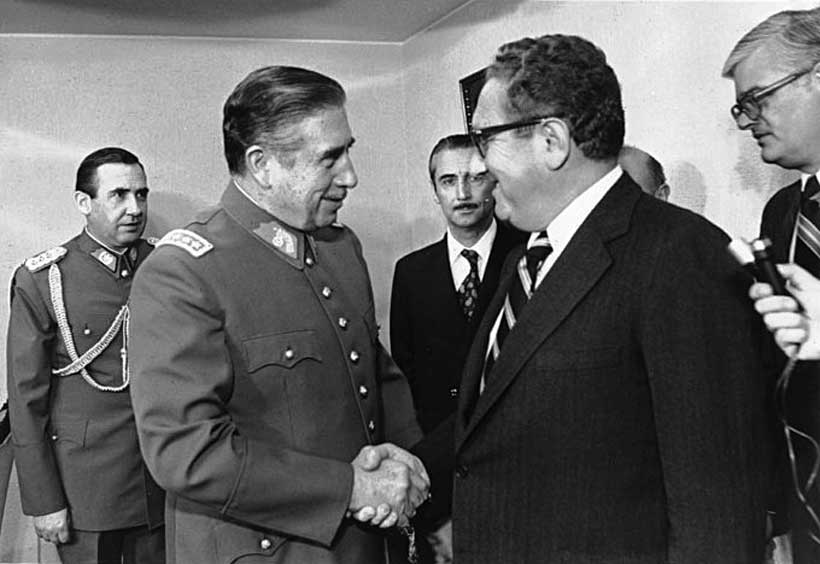
Augusto Pinochet shaking hands with Kissinger in 1976. This file is licensed under the Creative Commons Attribution 2.0 Chile license, via Wikipedia.
In the aftermath of World War II, the US emerged as a preeminent global power, and its foreign policy underwent a profound transformation shaped by the spectre of the Cold War. Defined by ideological rivalry with the Soviet Union, American foreign policy during this period was characterised by a strategic commitment to containment, preventing the spread of communism worldwide. The Truman Doctrine, Marshall Plan, and the establishment of NATO marked pivotal initiatives, reflecting a deep-seated determination to shape the post-war world order. This era saw the United States engage in complex geopolitical maneuvering, proxy conflicts, and diplomatic brinkmanship, as it sought to navigate the ideological fault lines that defined, both then and now, the Cold War. The ramifications of this foreign policy approach were vast, influencing international alliances, regional dynamics, and shaping the trajectory of global events for decades to come.
Henry Kissinger ascended to prominence in the United States during a pivotal era in global politics. Unbeknown to many, Henry Kissinger was born in Germany in 1923, fled the Nazis, and eventually found refuge in the United States, where he ended up becoming a professor at Harvard University. However, it was in the realm of foreign policy that Kissinger truly made his mark. Rising to prominence as National Security Advisor and later as Secretary of State under both Presidents Richard Nixon and Gerald Ford, Kissinger played a central role in shaping US international relations during the Cold War. Renowned for his realpolitik approach, he engaged in high-stakes diplomacy leaving an indelible mark on the geopolitical landscape.
In the annals of history, the enduring impact of Henry Kissinger on the shaping of US foreign policy unveils a disconcerting narrative of power, diplomacy, and a callous disregard for human rights. While his name is often associated with Southeast Asia and Cold War negotiations, the indelible scars of his influence in Latin America remain a lesser-explored facet of his legacy.
Against the backdrop of the Cold War, American foreign policy was driven by the overarching goal of containing the spread of communism globally. This geopolitical context provided the impetus for interventions and alliances that frequently prioritised strategic interests over democratic ideals, and the complete disregard of human rights.
More:
https://moderndiplomacy.eu/2023/12/03/from-vietnam-to-videla-henry-kissinger-and-the-forgotten-horrors-of-us-foreign-policy/
Henry Kissinger: The Declassified Obituary
The Primary Sources on Kissinger’s Controversial LegacyArchive Obtained and Published Previously Secret Records on Kissinger’s Role in Secret Bombing Campaigns in Cambodia, Illegal Domestic Spying, Support for Dictators, and Dirty Wars Abroad
Washington, D.C., November 29, 2023 - Henry Kissinger’s death today brings new global attention to the long paper trail of secret documents recording his policy deliberations, conversations, and directives on many initiatives for which he became famous—détente with the USSR, the opening to China, and Middle East shuttle diplomacy, among them.
This historical record also documents the darker side of Kissinger’s controversial tenure in power: his role in the overthrow of democracy and the rise of dictatorship in Chile; disdain for human rights and support for dirty, and even genocidal, wars abroad; secret bombing campaigns in Southeast Asia; and involvement in the Nixon administration’s criminal abuses, among them the secret wiretaps of his own top aides.
To contribute to a balanced and more comprehensive evaluation of Kissinger’s legacy, the National Security Archive has compiled a small, select dossier of declassified records—memos, memcons, and “telcons” that Kissinger wrote, said and/or read—documenting TOP SECRET deliberations, operations and policies during Kissinger’s time in the White House and Department of State.
The revealing “telcons”—over 30,000 pages of daily transcripts of Kissinger’s phone conversations which he secretly recorded and had his secretaries transcribe—were taken by Kissinger as “personal papers” when he left office in 1977 and used, selectively, to write his best-selling memoirs. The National Security Archive forced the U.S. government to recover these official records by preparing a lawsuit that argued that both the State Department and the National Archives and Records Administration (NARA) had inappropriately allowed classified U.S. government documentation to be removed from their control.
More:
https://nsarchive.gwu.edu/briefing-book/cold-war-henry-kissinger/2023-11-29/henry-kissinger-declassified-obituary-0
5:06 / 10:01 The Sound of Ancient Languages. Full Version. You Haven't Seen Anything Like This Before!
Premiered Oct 14, 2023
Dive into the fascinating realm of ancient languages with our enthralling video. Encounter the alluring sounds of historical civilizations through the skillful portrayal of lifelike characters. Embark on a journey through time, where you'll be serenaded by the melodious rhythms of forgotten dialects, each meticulously researched and expertly brought to life. From the enigmatic intonations of Egyptian hieroglyphics to the lyrical elegance of Latin, allow the echoes of the past to transport you to a world of linguistic marvels. Explore the linguistic legacy of our forebears and witness the enduring influence of language in safeguarding the heritage of ancient societies. Get ready to be spellbound as the voices of history's long-forgotten resurface once more.
Profile Information
Member since: 2002Number of posts: 160,525